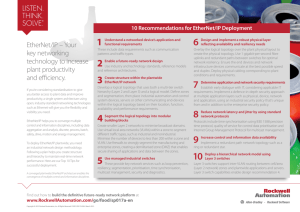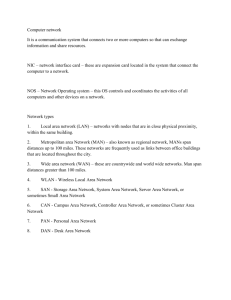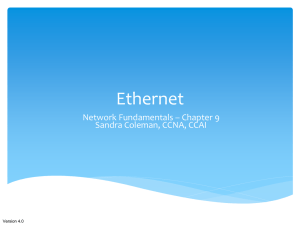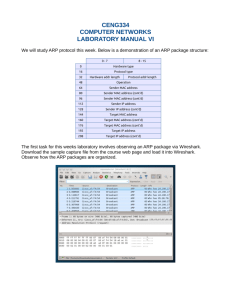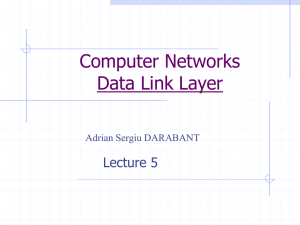Switched Local Area Networks - CS 460 Computer Communications
advertisement
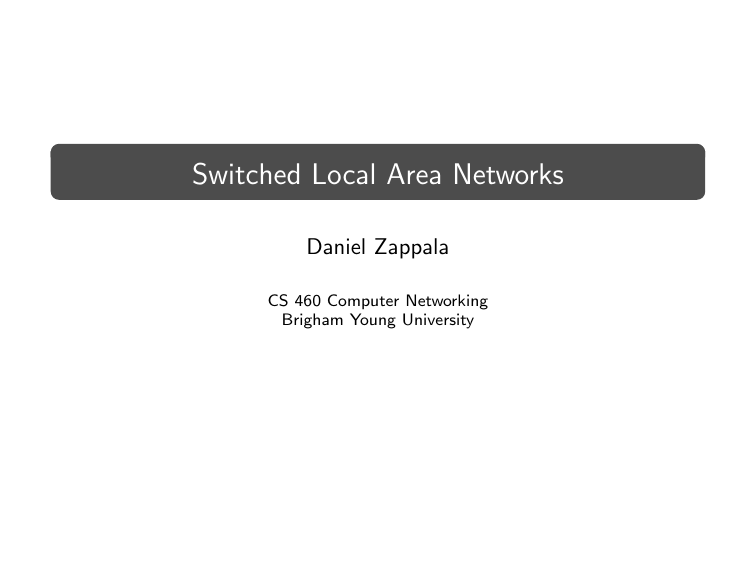
Switched Local Area Networks
Daniel Zappala
CS 460 Computer Networking
Brigham Young University
Addressing
Addressing
ARP
Ethernet
Switches
Local Area Network (LAN)
• broadcast channel shared among many hosts
• any frames sent to the broadcast address reach all hosts on the
LAN
• earlier: all frames broadcast, those who don’t want the data
ignore it (bus topology)
• now: frames sent to a particular MAC address reach only the
destination host (star topology)
3/24
Addressing
ARP
Ethernet
Switches
MAC Addresses
• used to get frame from one
interface to another
physically-connected
interface (on the same
network)
• most are 48 bits long,
depends on link-layer
protocol
• address burned into the
adapter ROM
• broadcast address usually all
ones (FF-FF-FF-FF-FF-FF)
4/24
Addressing
ARP
Ethernet
Switches
MAC Addresses are Globally Unique
• address assignment administered by IEEE
• manufacturer buys portion of MAC address space (prefix)
• uses that prefix for all MAC addresses and ensures it does not
reuse the suffix
• uniqueness provides address portability
• can move Ethernet card from one LAN to another
• don’t need hierarchy or aggregation like with IP addresses
because MAC addresses only used on one LAN
5/24
ARP
Addressing
ARP
Ethernet
Switches
ARP: Address Resolution Protocol
• when forwarding a packet with IP, a router knows when the
packet has reached its destination network
• how can the router determine the associated MAC address for
a given IP address?
7/24
Addressing
ARP
Ethernet
Switches
ARP: Address Resolution Protocol
• when forwarding a packet with IP, a router knows when the
packet has reached its destination network
• how can the router determine the associated MAC address for
a given IP address?
• keep an ARP table: maps an IP address to a MAC address
7/24
Addressing
ARP
Ethernet
Switches
Building an ARP Table
• ARP table entry
• IP address
• MAC address
• TTL (e.g. 20 minutes)
• host A has no entry for IP address B in table
• A broadcasts ARP query for B
• all hosts on LAN receive query
• host with address B responds by unicast to A with its MAC
address
• all hosts hear query and response, cache translations for A and
B in their ARP tables
• all hosts process all ARP packets, even if not addressed to
themselves
8/24
Addressing
ARP
Ethernet
Switches
ARP Example
• send packet from A to B via R
• need ARP from A to R, R to B
• ARP table for node 222.222.222.220
9/24
Ethernet
Addressing
ARP
Ethernet
Switches
Ethernet
• dominant wired LAN technology
• very inexpensive: $20 for 100 Mbps
• simpler and cheaper than FDDI (token ring), ATM
• speeds have improved dramatically over the years: 10 Mbps -
10 Gbps
11/24
Addressing
ARP
Ethernet
Switches
Ethernet Topologies
• originally used a bus
• now nearly all installations use a star: hub or switch
12/24
Addressing
ARP
Ethernet
Switches
Ethernet Frame Format
• IP packet encapsulated inside Ethernet Frame
• preamble: 7 bytes of 10101010 followed by one byte of
10101011
• used to synchronize the receiver and sender clock rates
• addresses: 6 bytes
• type: higher level protocol (IP, IPX (Netware), AppleTalk)
• CRC: error detection/correction
13/24
Addressing
ARP
Ethernet
Switches
Historic Ethernet
• 10base5 (thick ethernet)
• original standard
• coaxial cable, 500 meters max length, 10 Mbps
• bus topology, BNC connectors, must be terminated
• 10Base-2 (thin ethernet)
• coaxial cable, 185 meters max length, 10 Mbps
• bus topology, BNC connectors, must be terminated
14/24
Addressing
ARP
Ethernet
Switches
Modern Ethernet
• 10BaseT and 100BaseT (fast ethernet)
• star topology
• twisted pair, 100 m max distance between node and hub
• hub is a physical-layer bit repeater, no frame buffering
• all nodes effectively on same link
• Gigabit ethernet
• point-to-point links and shared links
• CSMA/CD only for shared links
• full duplex at 1 Gbps and now 10 Gbps for point-to-point links
15/24
Switches
Addressing
ARP
Ethernet
Switches
Hubs versus Switches
• hub: a bit repeater and signal amplifier
• connects two LAN segments together
• extends maximum distance between two nodes
• connects collision domains
• switch: link layer forwarding device
• stores and forwards frames using MAC address
• uses link-layer protocol when forwarding frames
• separates collision domains
• Ethernet switch: only handles Ethernet frames, uses
CSMA/CD on each LAN segment
17/24
Addressing
ARP
Ethernet
Switches
Switches versus Routers
• both use store-and-forward
• switches forward frames
• routers forward IP packets
• routers compute paths between IP networks using routing
algorithms
• switches use a learning algorithm to connect links forming a
single IP network
18/24
Addressing
ARP
Ethernet
Switches
Example Configuration
19/24
Addressing
ARP
Ethernet
Switches
Traffic Isolation
• each segment is a separate collision domain
• each segment receives data at its full link rate
• pairs of communicating hosts can operate at full speed
simultaneously
• cut-through-switching: switch begins forwarding frame as
soon as it reads the header
20/24
Addressing
ARP
Ethernet
Switches
Self-Learning Switches
• switch could forward all frames on all links: high overhead
• use a self-learning algorithm to determine where to forward
each frame
• learn which host can be reached on a given interface
• when the switch receives a frame, it learns that the source host
is on this interface
• record interface for the host in a switch table
• switch table entries
• MAC address
• interface
• timestamp (stale entries deleted)
21/24
Addressing
ARP
Ethernet
Switches
Switch Forwarding Algorithm
entry = switch_table{MACdestAddress}
if entry:
if MACdestAddress on arriving interface
drop frame
else:
entry.interface.forwardframe()
else:
for i in interfaces:
if i != arriving interface:
i.forwardframe()
• can the switch topology have loops?
22/24
Addressing
ARP
Ethernet
Switches
Switch Example
• switch delivers a frame from A to I - sends only on interface 3
• switch delivers a frame from A to C - sends on all interfaces
• switch delivers a frame from C to I - sends only on interface 3,
learns that C is on interface 1
23/24
Addressing
ARP
Ethernet
Switches
VLANs
• motivation
• want to limit the spread of broadcast traffic
• want to isolate traffic for small subnets, without requiring a
separate, physical switch for each subnet
• want the flexibility of moving hosts between subnets without
physically rewiring them
• use a single switch with intelligence that knows which ports
belong to which VLAN
• use a router within the switch to route between VLANs
24/24

